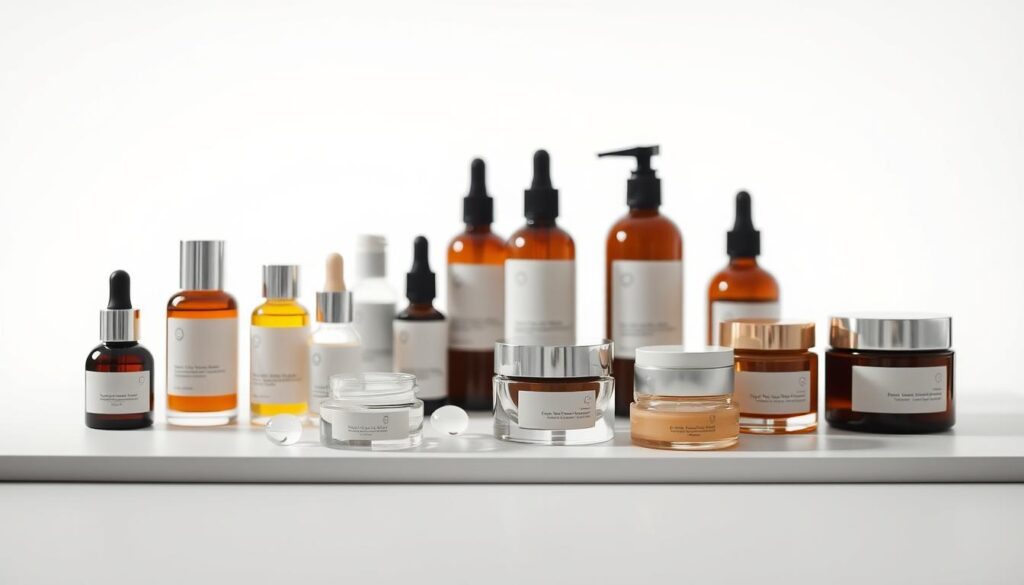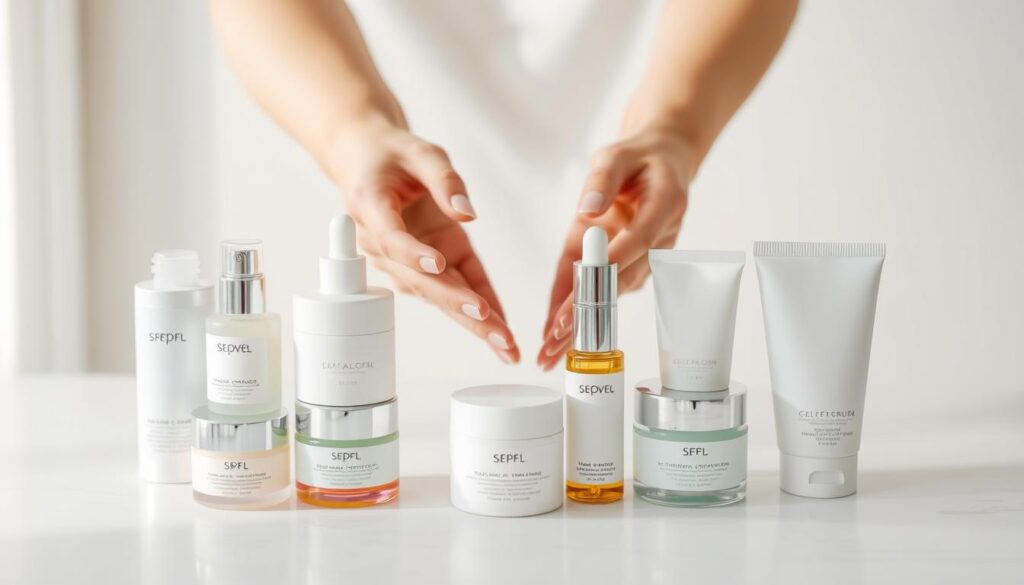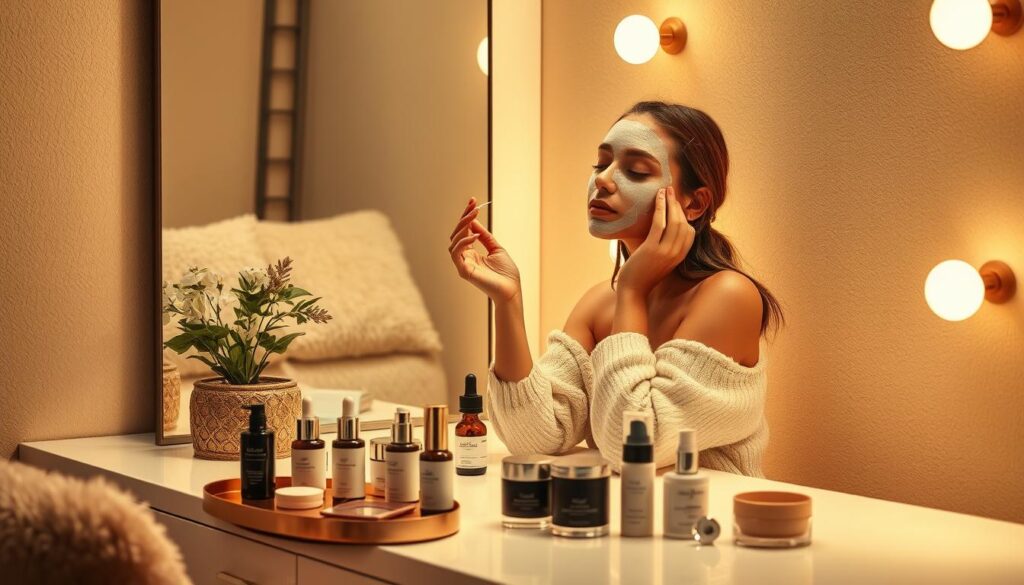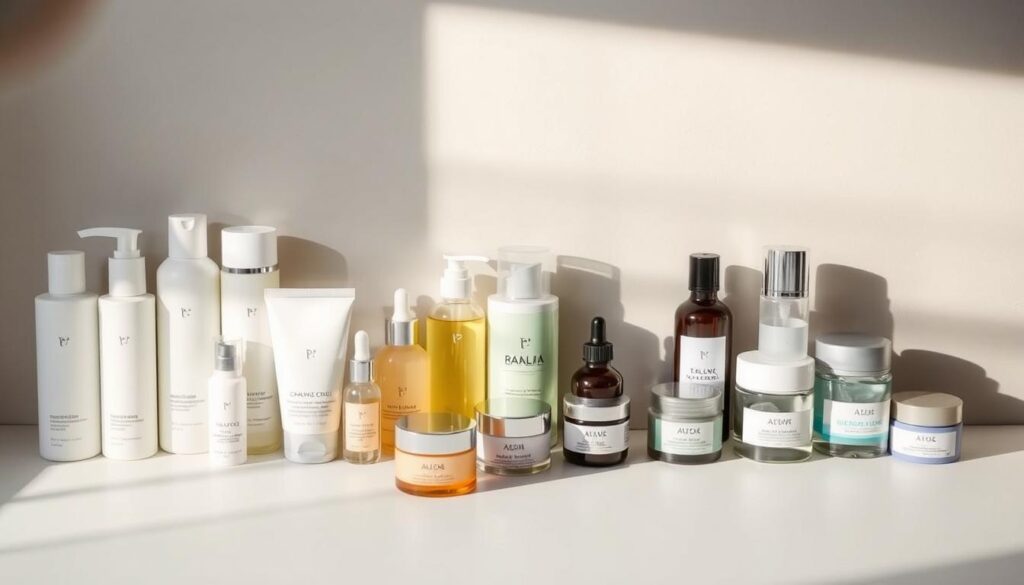- Key Takeaways
- Understanding the Importance of Proper Skincare Layering
- Step-by-Step Guide to Layering Skincare
- Essential Ingredients to Consider in Each Layer
- Daytime vs. Nighttime Skincare Routines
- Building a Personalized Skincare Routine
- Troubleshooting Common Skincare Layering Issues
- Expert Tips for Skincare Layering Success
Knowing the right order to layer skincare products is key to getting the most out of them. Even if you have the best products, applying them incorrectly can limit their benefits.
Creating a simple skincare routine can make a big difference. By layering your products correctly, you boost their absorption and effectiveness. This leads to healthier, more radiant skin.
For more such content VISIT: https://besttopt10.com/
Key Takeaways
- Layering skincare products in the correct order enhances their effectiveness.
- A well-structured skincare routine is simple and beneficial.
- Correct layering improves product absorption and skin health.
- Understanding your skin type is key to choosing the right products.
- Consistency is key to seeing results from your skincare routine.
Understanding the Importance of Proper Skincare Layering
Proper skincare layering is more than just applying products randomly. It’s about making a routine that works together to solve your skin problems. When done right, layering skincare products can make your routine much more effective.

Benefits of Layering Skincare Correctly
Layering skincare products the right way has many benefits. These include:
- Enhanced product absorption: Applying products in the right order ensures they soak into your skin well.
- Improved skin health: The right layering tackles issues like acne, dark spots, or dry skin.
- Maximized product efficacy: When layered correctly, ingredients work better together, giving you better results.
Knowing the best order to apply skincare products is key to getting the most out of them. Products should go from thinnest to thickest. This allows for the best absorption and effectiveness.
Common Misconceptions About Layering
Many think that using more products means better results. But, too many products can irritate your skin or clog pores, if they don’t match your skin type.
Some also believe that the order of application doesn’t matter, as long as you use the right products. But, the order really does affect how well your skincare works.
By understanding the right way to layer and avoiding common mistakes, you can make a skincare routine that really meets your skin’s needs. This will improve your skin health and look.
Step-by-Step Guide to Layering Skincare
To get healthy, glowing skin, learning how to layer skincare is key. The right order of products makes your routine more effective.
Cleanser: Preparing Your Skin
Cleansing is the first step. Use a cleanser that matches your skin type. Massage it on a damp face, then rinse with warm water. This removes dirt, oil, and makeup, getting your skin ready for more.
Toner: Balancing the Skin’s pH
Next, use a toner to balance your skin’s pH and close pores. Toners also add active ingredients for skin renewal. Dampen a cotton pad with toner and gently wipe your face, skipping the eye area.

Serums: Targeting Specific Concerns
Serums are strong formulas for specific issues like acne, aging, or dark spots. Apply a few drops to your face and pat it in until it’s fully absorbed. Their light texture lets them reach deep into your skin.
Moisturizer: Locking in Hydration
Lastly, apply a moisturizer to keep everything in place and protect against the environment. Choose a moisturizer that fits your skin type, from light lotions for oily skin to thick creams for dry skin.
By following this guide, you make sure your skin gets the most from each product. This leads to a better skincare routine.
Essential Ingredients to Consider in Each Layer
Good skincare layering is about more than just the order of products. It’s also about the ingredients in each layer. Knowing the right ingredients for each step can really boost your skincare routine’s effectiveness.
Hydrating Ingredients to Look For
Keeping your skin hydrated is key. Look for products with hyaluronic acid, glycerin, and ceramides. These ingredients help keep moisture in and support your skin’s barrier.
- Hyaluronic Acid: It can hold up to 1000 times its weight in water, making it a strong humectant.
- Glycerin: It draws moisture to your skin, keeping it hydrated and plump.
- Ceramides: They’re vital for fixing your skin’s barrier. Ceramides help lock in moisture and protect against environmental stressors.
Active Ingredients: When to Use Retinol and Vitamin C
Active ingredients like retinol and vitamin C tackle specific skin issues. Retinol, a vitamin A derivative, is great for anti-aging and skin renewal. Vitamin C, on the other hand, is a strong antioxidant that brightens and protects your skin.
- Retinol: Use it at night because it’s sensitive to sunlight. It promotes cell turnover and collagen production.
- Vitamin C: Apply it in the morning. It neutralizes free radicals and boosts skin brightness.
Sun Protection: Why it Should Be Last
Sun protection is vital in your daytime skincare routine. A broad-spectrum sunscreen with at least SPF 30 protects your skin from UV damage. This prevents premature aging and skin cancer.
- Broad-Spectrum Protection: Covers both UVA and UVB rays.
- SPF 30 or Higher: Provides enough protection for daily use, even on cloudy days.
By adding these essential ingredients to your skincare layering, you can get healthier, more resilient skin. Your skin will look its best.
Daytime vs. Nighttime Skincare Routines
Your skin needs different things during the day and at night. It’s important to change your skincare routine for these times. During the day, your skin faces UV rays and pollution. At night, it works on healing and fixing itself.
Daytime Products and Their Purpose
Daytime skincare helps protect your skin from daily harm. A broad-spectrum sunscreen with SPF 30 is key. Also, use a light moisturizer and an antioxidant serum to keep your skin safe.
- Apply a broad-spectrum sunscreen with SPF 30 or higher.
- Use a lightweight moisturizer to hydrate without clogging pores.
- Incorporate an antioxidant serum to combat free radicals.
Nighttime: Recovery and Repair
Night is when your skin heals and rejuvenates. Use richer moisturizers, exfoliants, and treatments like retinol or peptides at night.

- Rich moisturizers or night creams to lock in hydration.
- Exfoliants containing alpha-hydroxy acids (AHAs) or beta-hydroxy acids (BHAs) to remove dead skin cells.
- Retinol or peptide treatments to stimulate collagen production and reduce fine lines.
By adjusting your skincare routine for day and night, you can get a balanced, healthy, and glowing skin.
Building a Personalized Skincare Routine
Creating a skincare routine that fits your skin type and concerns is essential. Everyone’s skin is different, so what works for one might not work for another. To make a good routine, you need to know your skin, find out what bothers you, and pick products that go well together.
Assessing Your Skin Type
First, figure out your skin type. There are four main types: normal, dry, oily, and combination. Knowing your type helps you pick the right products for your skin.
- Normal Skin: Balanced skin that is neither too oily nor too dry.
- Dry Skin: Skin that feels tight, rough, or flaky due to a lack of moisture.
- Oily Skin: Skin that appears shiny or greasy, mainly in the T-zone (forehead, nose, and chin).
- Combination Skin: Skin that is oily in some areas (like the T-zone) and dry or normal in others.
Identifying Your Skin Concerns
After figuring out your skin type, find out what concerns you. These can be acne, hyperpigmentation, fine lines, or loss of firmness. Knowing what bothers you helps you pick the right products.
Common concerns include:
- Acne and breakouts
- Dullness and uneven skin tone
- Fine lines and wrinkles
- Loss of firmness and elasticity
- Hyperpigmentation and dark spots
Selecting Products That Work Together
Now, pick products that work well together. Look for ones that tackle your specific concerns and fit your skin type.
Here are some tips for choosing products:
- Choose a gentle cleanser that effectively cleans your skin without stripping it of its natural oils.
- Select a toner that balances your skin’s pH and prepares it for subsequent products.
- Use serums that contain active ingredients targeting your specific skin concerns.
- Apply a moisturizer that provides the right level of hydration for your skin type.
- Don’t forget sunscreen with at least SPF 30 for daytime protection.

Troubleshooting Common Skincare Layering Issues
Layering skincare products is more than just applying multiple layers. It’s about doing it right to get the best results. Even with the right products, wrong layering can make them less effective or even irritate your skin. We’ll look at common problems and how to fix them.
When Products Don’t Play Well Together
One big issue is when products don’t mix well. Some ingredients can cancel each other out or cause bad reactions. For example, using vitamin C products with niacinamide can sometimes irritate your skin or make both products less effective.
To solve this, know what’s in your products and how they work together. Here are some tips to make sure your products get along:
- Check the pH level of your products to ensure they are compatible.
- Avoid mixing products with active ingredients that are known to be unstable when combined.
- Patch test new product combinations on a small area of your skin before fully incorporating them into your routine.
Signs of Overloading Your Skin
Using too many products can clog pores, irritate your skin, and weaken your skin barrier. Signs you’re overloading include increased sensitivity, redness, and breakouts.
To avoid this, keep your routine simple by focusing on essential products. Here’s how to simplify:
- Identify your primary skin concerns and select products that target these issues.
- Gradually introduce new products into your routine, monitoring your skin’s response.
- Remove products that don’t provide noticeable benefits or cause adverse reactions.
By being careful with how you layer your skincare and watching how your skin reacts, you can create a better routine.
Expert Tips for Skincare Layering Success
Learning to layer skincare can seem hard, but with some tips, you can get it right. A good step by step skincare layering plan is key to making your skin look its best.
Simplifying Your Routine
When it comes to skincare, it’s better to keep it simple. Too many products can irritate your skin and not work well. Choose a few products that work well together for a great skincare regimen layering sequence.
Seasonal Adjustments
As the seasons change, so should your skincare. In winter, you might need more moisturizing products. In summer, lighter products and more sun protection are key. Adjusting your routine for the season keeps your skin healthy.
The Power of Consistency
Consistency is key in skincare. Stick to your routine and let your skin adjust. With patience and persistence, you’ll get the glowing skin you want.

